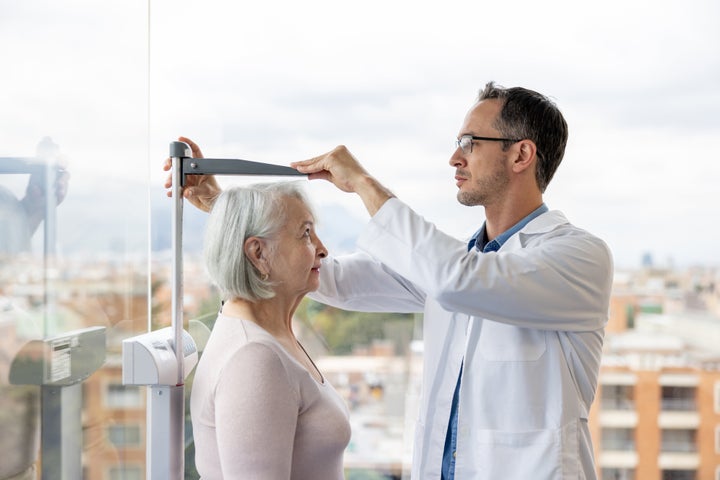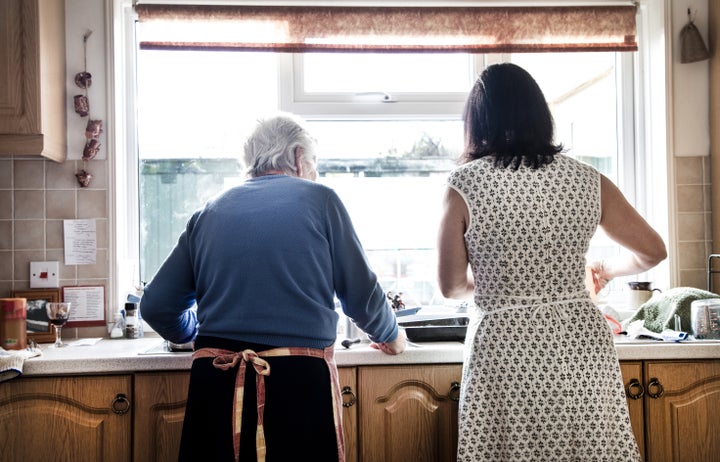
It seems that everything shifts as you age. You may notice you get wrinkles, your hair turns gray and even your height changes — in other words, you shrink.
“Aging is not a random thing that happens, it’s very predictable, it happens to us all. And rather than just luck and some bad things that might happen to you, there is a whole biology that has been evolving in identifying why all these changes happen to our body,” said Dr. Douglas Kiel, a professor of medicine at Harvard Medical School and the director of the Musculoskeletal Research Center and senior scientist at Marcus Institute for Aging Research in Massachusetts.
Losing some height is one of those changes. But how much you shrink once you hit mid-life depends on a few factors (the exact amount that you might shrink isn’t 100% agreed on).
Kiel said shrinking less than an inch is normal and any more than that may be indicative of underlying issues (more on that below). Dr. James Harrop, the chief of the division of spine and peripheral nerve surgery at Thomas Jefferson University Hospital in Philadelphia, added that men lose about .02% of their height per year while women lose .1% per year on average.
The University of Arkansas for Medical Sciences reports men shrink about 1 inch in their lifetime while women shrink 2 inches.
While the amount may vary depending on the person, shrinking overall is usually normal. Below, experts explain why it happens and when you may need to be concerned.
Your muscles become weaker, which makes it harder to hold your spine upright.
“So, one reason that height might be reduced is that you are curved forward,” Kiel said, explaining that people tend to hunch as they get older. “If you stretched yourself out, your height might not be as much reduced, but since you can’t stand up totally straight ... you measure a lower height.”
This curvature is referred to as kyphosis, he said. Every one of us has some variation of this in our spine, “but with aging, it’s often observed that the kyphosis, that slight curvature, becomes more pronounced.”
Muscles are required to keep your spine straight, and usually you lose those muscles as you have more birthdays. “You lose muscle fibers with aging, so the ability to extend your spine and look straight and tall are not as good as they were when you were younger. And so that kyphosis is more pronounced, and therefore your height is reduced,” Kiel said.
Bone loss is another contributing factor to shrinkage.
Part of what makes up our height are vertebral bodies, which are part of the vertebrae that make up our spine. “If you are losing bone as you age, sometimes the vertebral bodies ... actually are crushed,” Kiel noted. This means they get less tall, making us less tall, too.
And sometimes these vertebral bodies actually break. “It’s called a vertebral fracture, and a vertebral fracture reduces the height of the vertebral bodies,” Kiel added. “You have a lot of vertebral bodies in your body going from the lower part to the middle, all the way up to your skull, and if one or more of those vertebral bodies loses its height — even though it’s only one small part of the spine — you can lose height,” Kiel said.
You may be completely unaware if you do have these fractures, Harrop said. Two-thirds of people with vertebral fractures do not feel any pain. You may also just think you pulled something in your back, according to both experts.
People with osteoporosis, which is a loss of bone, tend to have more vertebral fractures, Kiel noted.
Harrop said that when he sees someone with osteoporosis and a spine problem come into his office, he gets nervous because if you have a fracture and “you don’t get treated, you have a 30% chance of having another fracture within one year.” And more and more fractures cause angulation in the spine, resulting in shrinking, Harrop noted.

The discs in your spine lose height as well.
You’ve likely heard of a slipped disc (or maybe you’ve even had one). Those discs, which are known as intervertebral discs, are another piece of the shrinking puzzle.
“A disc is really a shock absorber or a pillow between two bones,” said Dr. Raz Winiarsky, an orthopedic surgeon at Brooklyn Premier Orthopedics. “And, essentially, when over time, starting in middle-age or actually starting a little earlier, like in your 40s, the amount of water in the disc ... dissipates or dries out.”
This drying out shrinks the discs and leads to less disc height, which can impact your height. According to Harrop, by the time you’re 60 or 70, your disc can go from about 10 to 13 millimeters in height to 1 to 2 millimeters due to disc degeneration.
“Now, you do that with your 23 discs, and you can obviously see that’s a significant loss of height,” Harrop said.
So, is there a way to stop this from happening?
“If I could give one public service announcement, [it’s that] everyone ... should get their bone density checked and they should be treated if they have osteoporosis,” Harrop stressed.
A bone density test won’t totally stop you from shrinking but will alert you of any problems that could exacerbate it.
“When people reach age 65, Medicare pays for a bone density test, which is a way of quantifying how much bone you still have left and ... some of the machines can have the patient roll on his or her side and get a side view of vertebral bodies to see if there are any of those compression fractures,” Kiel added.
You may be eligible to get a bone density test before 65; for example, Kiel said that many women are encouraged to do so during menopause. Additionally, Harrop said if you have a spine problem like scoliosis, it’s that much more important to get your bone density checked. Talk to your primary care physician to see if you qualify.
What’s more, a healthy lifestyle can help slow down any shrinkage as well. “If you really want to not lose bulk and try to ... actually maintain your bone density, the best thing in the world is to exercise,” Winiarsky said. “It’s never too late to start, but the best thing is to have a life of healthy exercise where you do it a half an hour a day.”
This will help you maintain the strength of your bones and the strength of the muscles that help you hold your spine up.
“Shrinking is not a disease, but it ... could be an indicator that some things are changing in your body that potentially could be slowed down,” Kiel said. “You have muscle, you have discs, you have bones, and they’re all contributing to shrinking, and if you shrink a lot it could mean more losses are occurring in those three contributors.”